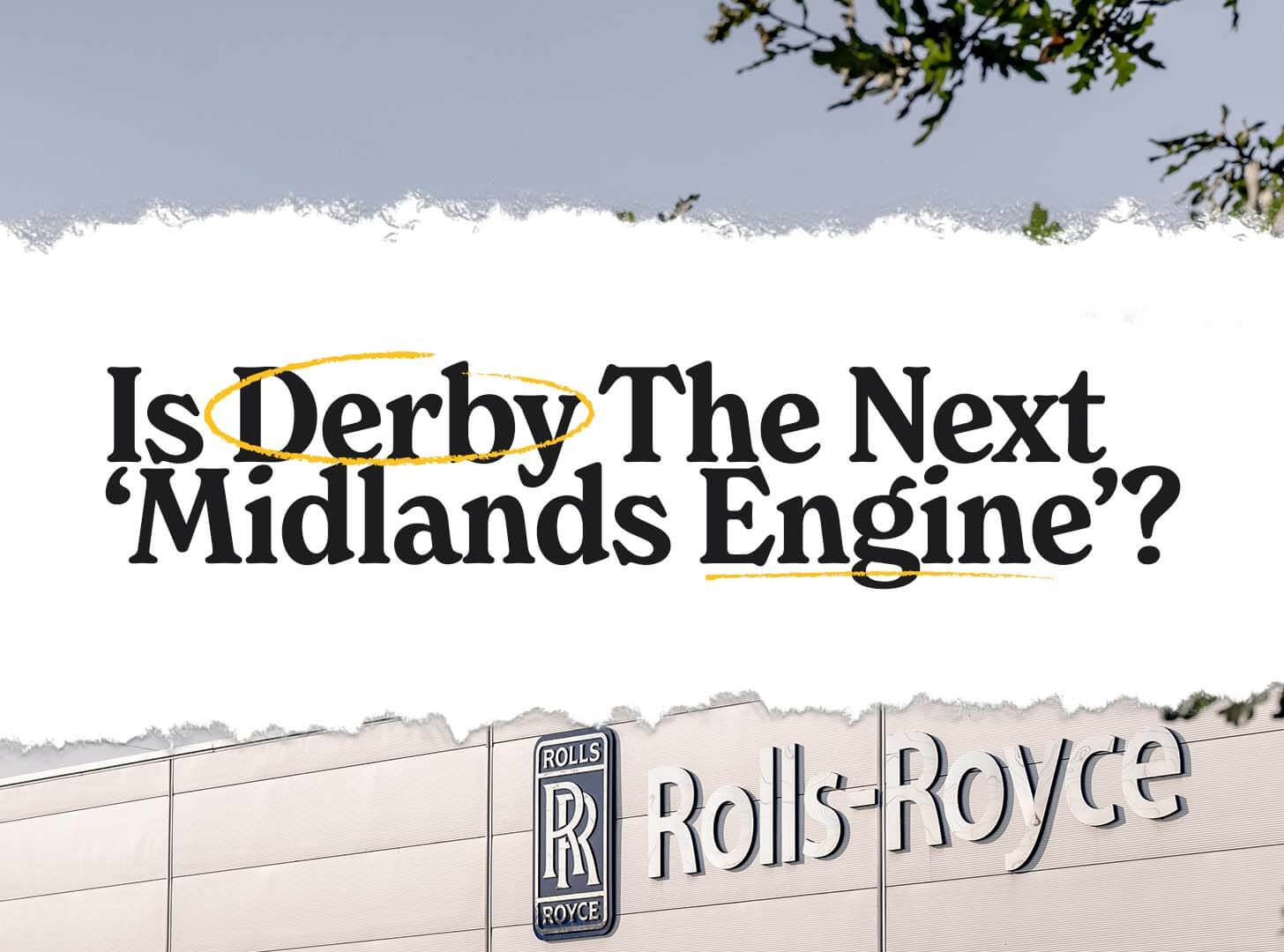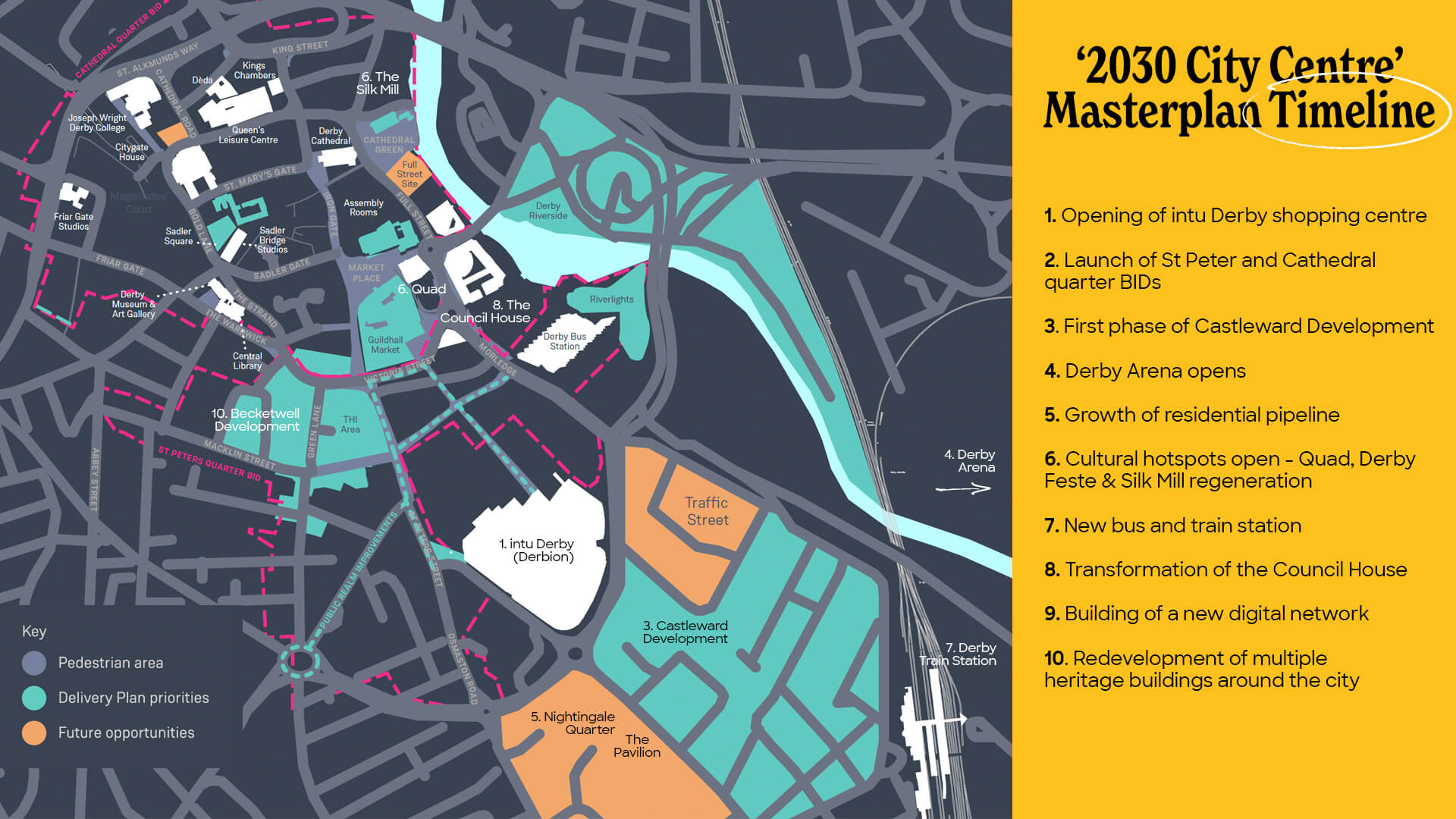Is Derby the Next ‘Midlands Engine’?

Over the last decade, cities across the UK have reinvented themselves, using inward investment to build new amenities such as transport links, cultural experiences and public spaces.
This ‘regeneration’ has helped many cities transform themselves into hubs of business, leisure and retail, with the increased demand from both tenants and buyers supporting positive property growth in these new investment hotspots.
Now, we’re seeing a new wave of ‘master plans’ that is creating new investment locations, turning emerging markets into fully-fledged investment destinations.
The ‘2030 Derby Masterplan’ is one such project. Born out of nearly £3.5 billion worth of inward investment, how will this long-term scheme help Derby enter the next phase of its transformation? And what could the city learn from those who paved the way before it?
Related: 7 Things You Don’t Know About Derby
What did ‘The Big City Plan’ look like?
Before we explore how the 2030 Derby Masterplan could change Derby, it’s worth exploring how previous ‘master plans’ have impacted their cities.
One of the first cities to adopt a large-scale project was Birmingham.
The ‘Big City Plan’ was a long-term regeneration project launched in the early 2000s alongside the opening of the Bull Ring. Originally planned to span 20 years, it had key goals of:
- Creating 1.5 million sq.m of new floorspace
- Generating 50,000 new jobs
- Building 65,000 sq.m of new public spaces
- Contributing £2.1 billion to the local economy
- Creating 5,000 new homes to attract more families
- Maintaining, valuing and expanding the city’s cultural assets
- Addressing the impact of climate change on the city-centre
Within the plan, Birmingham had several key projects that would help transform its skyline, as well as the amenities for residents:
- Bull Ring
- Snowhill
- West Midlands Metro
- The Library of Birmingham
- The Cube
- Paradise
- Grand Central
- Birmingham Coach Station
- HS2
These new developments would help turn Birmingham into a true destination, providing new transport links, cultural hotspots and mixed-use space for commercial and retail business.
In turn, these developments would drive the future of Birmingham’s residential sector, attracting new tenants moving to the city for the employment opportunities and lifestyle on offer.
How did the ‘Big City Plan’ impact Birmingham?
The impact of the ‘Big City Plan’ was immediately apparent for Birmingham.
The Bull Ring, originally opened in 2003, transformed the city’s retail offering and remains one of the busiest shopping centres in the country, attracting nearly 36.9 million visitors and raising around £1 billion a year.
Over the years Birmingham continued to build, slowly breaking down the ‘concrete jungle’ label it once held and creating stunning new amenities.
In 2010, even as the country recovered from the global financial crisis, Birmingham had a solid foundation for incredible growth – both economically and physically.
Cranes littered the skyline and following the opening of Snowhill and The Library of Birmingham, the power of the second city could hardly be denied.
KPMG and Barclays were some of the first major companies to move their headquarters to Birmingham, closely followed by Deutsche Bank, PwC, HSBC and now, Goldman Sachs.
Birmingham had steadily built an incredible professional hub off the back of the ‘Big City Plan’, which in turn has attracted hundreds of thousands of new potential buyers or tenants to the city’s residential sector.
For the property market, this translated to prices rising by nearly 58% between 2011 and 2022.
Crucially, this exceptional start to the ‘Big City Plan’ also led to two important transport projects – High Speed 2 and West Midlands Metro.
The former, a high-speed rail line between London and Birmingham, is a once-in-a-generation project that will reduce travel times to 49 minutes and introduce a whole new market to Birmingham property.
The latter is a large-scale rail project that has helped anchor Birmingham as the ‘Midlands Engine’ while utilising the power of the West Midlands to raise the entire region up. Now more than ever, Birmingham is connected with talent across not just the West Midlands but the entire country.
What is the ‘2030 Derby Masterplan’?
With the success of Birmingham’s ‘Big City Plan’ in mind, how could a similar project impact Derby?
Ultimately, the goals of the ‘2030 Derby Masterplan’ are as follows:
- Leverage £3.5 billion in investment by 2030
- Create 4,000 new jobs for the city
- Deliver 1,900 new homes for the city
- Rejuvenate the Assembly Rooms and Silk Mill
- Drive the Becketwell Regeneration and The Market Place Redevelopment
- Create a ‘connected city’ with more focus on placemaking
- Develop new public realm, city-centre offices and residential spaces such as Nightingale Quarter and Castleward Urban Village
Looking to the future, first and foremost, Derby has all of the similarities that Birmingham had at the start of last decade.
It’s an affordable property market, incredibly well-connected (even more so than Birmingham) and anchors a popular region in the Midlands.
The city is underpinned by a thriving manufacturing sector, led by the likes of Rolls-Royce, Bombardier and Toyota, all of which contribute around 45,000 roles to the city.
This in itself is driving more people to the city, especially working professionals and uniquely, graduates. 46% of graduates move to Derby with no prior links to the city because of the opportunities it can provide for new workers.

Source: Derby Gov
Related: Which City Has the Best Graduate Salary in the UK?
In tandem with this rise in demand, Derby is looking to help support the advent of a new progressive digital sector, filled with exciting start-ups that will build on the manufacturing groundwork already in place.
This development has largely been brought on by a lack of grade-A office space in the city-centre, which the 2030 Derby Masterplan is hoping to combat by building the most prestigious buildings possible for premier office users. These offices will feature high-quality finishes and state-of-the-art systems to establish a definite market presence.
By creating these new spaces, Derby is building a landscape to accommodate new businesses, many of which will be attracted to the demand that the city is seeing. This will help Derby establish itself as the new ‘Midlands Engine’, driving a thriving economy and commercial landscape from the East Midlands.
Overall, Derby’s regeneration projects will spread far and wide, with the intention of making the city a destination for living and working by 2030. Already, we’re seeing examples of this with the redevelopment of the Assembly Rooms, the Silk Mill and Becketwell, which are creating the cultural and leisure hotspots to match the rising business sector.
Going forward, Derby is in an excellent place to start building on the current foundations and as new amenities open, the city is in a prime position to follow in the footsteps of Birmingham and establish itself as a brand new investment hotspot.
